Santa Ana Sucker
-
Scientific NameCatostomus santaanae
-
NativeNative Species
-
Identification
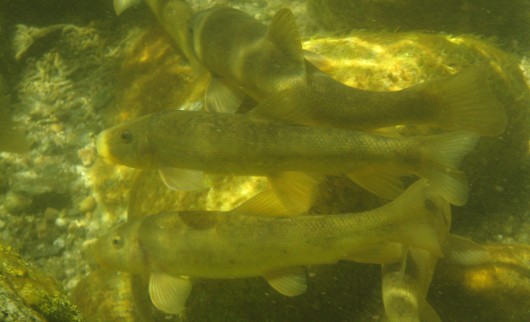 Santa Ana sucker, group, underwater in the San Gabriel River, CA, on 06/27/2007. Photo by Manna Warburton.
Santa Ana sucker, group, underwater in the San Gabriel River, CA, on 06/27/2007. Photo by Manna Warburton.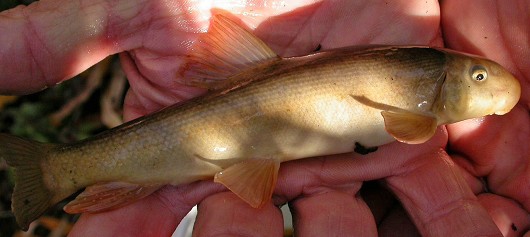 Santa Ana sucker, captured from Haines Creek, Los Angeles County, CA on 12 January 2004. Photo by Steve Howard.
Santa Ana sucker, captured from Haines Creek, Los Angeles County, CA on 12 January 2004. Photo by Steve Howard.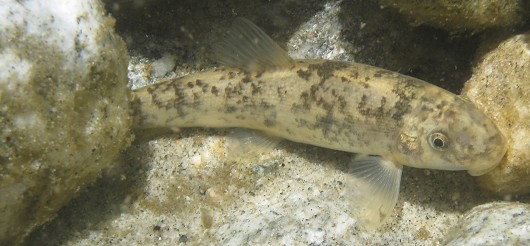 Santa Ana sucker, behind rock, in the San Gabriel River, CA, on 06/27/2007. Photo by Manna Warburton.
Santa Ana sucker, behind rock, in the San Gabriel River, CA, on 06/27/2007. Photo by Manna Warburton.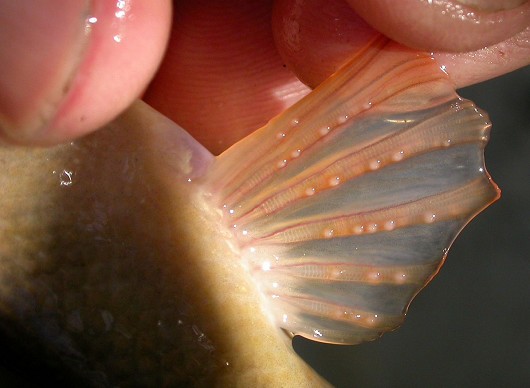 Santa Ana sucker (fin, showing tubercles), captured from Haines Creek, Los Angeles County, CA on 12 January 2004. Photo by Steve Howard.
Santa Ana sucker (fin, showing tubercles), captured from Haines Creek, Los Angeles County, CA on 12 January 2004. Photo by Steve Howard.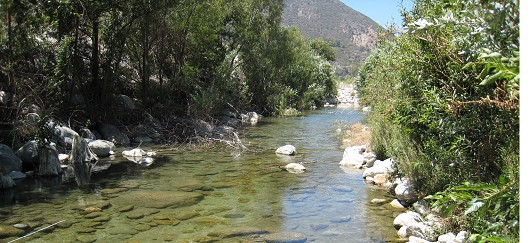 Santa Ana sucker habitat on the San Gabriel River, CA, on 06/27/2007. Photo by Manna Warburton.
Santa Ana sucker habitat on the San Gabriel River, CA, on 06/27/2007. Photo by Manna Warburton.- Small suckers: typically
- Deep caudal peduncle: 8-11 % of TL
- Subterminal mouth: deep notches separating upper and lower lips
- Shallow median cleft in lower lip: 3-4 complete rows of large papillae
- Cartilaginous scrapers inside lips
- Dark gray back and sides, silvery white underside, faint lateral stripes, dark dorsal blotches on sides
- Caudal fin membrane dark between rays
- Breeding males: tubercles on lower half of caudal peduncle, anal, and caudal fins
- Breeding females: tubercles on caudal peduncle and anal fin
- Fin rays: dorsal 9-11, pelvic 8-10
- Lateral line scales: 67-86
-
Life History
Santa Ana suckers are primarily found in small to medium sized streams that flow year-round and may vary in depth from several centimeters to over 1 m deep. They favor cool (<22°C) flowing water where gravel, rubble, and boulder substrates are present. While Santa Ana suckers are commonly found in association with algae, they are not normally found among macrophytes. They use their scraping mouths to feed on algae and detritus, and may also feed on insects. The sucker’s natal streams are subject to severe flooding, though these fish are well adapted to re-colonize through early maturity, high fecundity, and extended spawning. Santa Ana suckers rarely live more than four years but they reach sexual maturity in their second summer. Spawning occurs in gravelly riffles from mid-March until early June. Breeding behavior is probably very similar to that of other suckers with females being attended to by two or more males. Eggs are fertilized immediately because male fish release their milt as female fish deposit eggs. Female suckers release a total of about 4,000-16,000 eggs through multiple spawning acts. The fertilized eggs fall to the substrate where they stick to the gravel and incubate for approximately 36 hours. The emergent larvae develop a sub-terminal mouth when they reach a standard length of 16 mm.
Underwater video of Santa Ana suckers:
Underwater video of Santa Ana suckers swimming and feeding in the San Gabriel River, CA. Video by Manna Warburton.
-
Links to Other ResearchN / A
-
Watershed
-
Los Angeles Watershed
-
San Gabriel Watershed
-
Santa Ana Watershed
-
Santa Clara Watershed
-
Please note, watersheds are at the USGS 8-digit Hydrologic Unit Code (HUC) scale, so they often include a lot of sub-watersheds. If a species occurs in any sub-watershed within the HUC, the species appears within the HUC. Link to an EPA page that shows HUCs.




